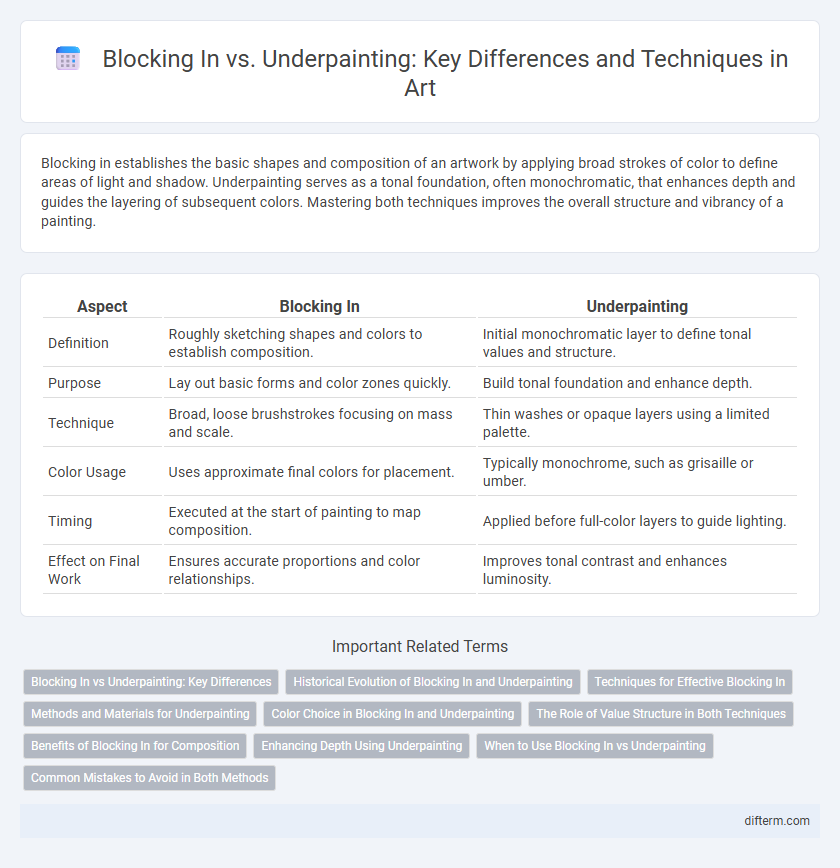Blocking in establishes the basic shapes and composition of an artwork by applying broad strokes of color to define areas of light and shadow. Underpainting serves as a tonal foundation, often monochromatic, that enhances depth and guides the layering of subsequent colors. Mastering both techniques improves the overall structure and vibrancy of a painting.
Table of Comparison
| Aspect | Blocking In | Underpainting |
|---|---|---|
| Definition | Roughly sketching shapes and colors to establish composition. | Initial monochromatic layer to define tonal values and structure. |
| Purpose | Lay out basic forms and color zones quickly. | Build tonal foundation and enhance depth. |
| Technique | Broad, loose brushstrokes focusing on mass and scale. | Thin washes or opaque layers using a limited palette. |
| Color Usage | Uses approximate final colors for placement. | Typically monochrome, such as grisaille or umber. |
| Timing | Executed at the start of painting to map composition. | Applied before full-color layers to guide lighting. |
| Effect on Final Work | Ensures accurate proportions and color relationships. | Improves tonal contrast and enhances luminosity. |
Blocking In vs Underpainting: Key Differences
Blocking in and underpainting serve distinct purposes in the painting process; blocking in involves applying large, flat areas of color to establish composition and basic forms rapidly. Underpainting acts as a tonal foundation, often monochromatic, that enhances depth and value contrast before adding detailed layers. Understanding these key differences helps artists build structure first with blocking in and refine with underpainting for richer, more dimensional artwork.
Historical Evolution of Blocking In and Underpainting
Blocking in and underpainting techniques have evolved significantly since the Renaissance, with blocking in initially serving as a rough compositional sketch using broad, opaque strokes to map out forms and color placement. Underpainting emerged as a more refined preparatory layer, often monochromatic, influencing tonal values and depth while providing a foundation for glazing methods developed in the Baroque period. This historical evolution highlights artists' experimentation with layering to enhance realism and luminosity, exemplified by masters like Leonardo da Vinci and Jan van Eyck.
Techniques for Effective Blocking In
Effective blocking in involves applying large, flat areas of color to establish the composition's basic shapes and values, enabling artists to quickly define spatial relationships and tonal contrasts. Utilizing broad brushes or palette knives facilitates smooth coverage and sharp edges, promoting clarity in the underlayers. This technique emphasizes color placement and value accuracy to create a solid foundation before detailed underpainting is introduced.
Methods and Materials for Underpainting
Underpainting involves applying a monochromatic base layer, typically using fast-drying materials like acrylic or oil paint thinned with turpentine, to establish tonal values and composition before adding colors. Common methods include imprimatura, a transparent tinted ground, and grisaille, a grayscale rendering that defines light and shadow. Artists select underpainting materials that ensure adhesion and durability, influencing the texture and depth of the final artwork.
Color Choice in Blocking In and Underpainting
Blocking in involves applying large areas of color to establish the composition's basic shapes and overall color scheme, using bold and accurate hues to set the visual tone early. Underpainting focuses on creating a tonal foundation, often utilizing monochromatic or limited palettes such as earth tones or grayscale to define light, shadow, and form before layering more complex colors. Precise color choice during blocking in ensures harmony and balance, while underpainting emphasizes value contrast and depth, guiding subsequent color application.
The Role of Value Structure in Both Techniques
Blocking in establishes the initial value structure by applying broad, opaque color areas to define composition and tonal relationships, setting the foundation for subsequent detail. Underpainting uses a monochromatic or limited palette to create a value map that enhances depth and contrast, guiding the layering of colors for a cohesive final image. Both techniques rely on mastering value structure to control light, shadow, and spatial perception in the artwork.
Benefits of Blocking In for Composition
Blocking in allows artists to quickly establish the overall composition by laying down basic shapes and tones, creating a strong foundation for the artwork. This technique enhances spatial relationships and balance in the painting, making it easier to adjust elements before committing to finer details. Rapid visualization of the composition through blocking in also improves decision-making and workflow efficiency in the creative process.
Enhancing Depth Using Underpainting
Underpainting establishes a monochromatic base layer that enhances depth by allowing subsequent colors to interact with tonal values beneath. This technique creates a luminous effect, as translucent layers reveal underlying contrasts, enriching the overall dimensionality of the artwork. Blocking in, by comparison, is a straightforward method of laying out shapes without the tonal complexity that underpainting provides.
When to Use Blocking In vs Underpainting
Blocking in is ideal during the early stages of a painting to rapidly establish basic shapes, composition, and value relationships, helping artists map out the overall structure without focusing on details. Underpainting is best suited for creating a tonal foundation that guides the layering of colors and enhances depth, often used when artists want to build a cohesive color scheme and refine light and shadow dynamics. Choosing between blocking in and underpainting depends on whether the artist prioritizes quick compositional layout or a detailed tonal groundwork to influence subsequent painting layers.
Common Mistakes to Avoid in Both Methods
Common mistakes in blocking in and underpainting techniques include applying paint too thickly, which hinders drying and layering, and neglecting proper value contrast, resulting in flat compositions. Artists often overlook the importance of clean edges in blocking in, causing muddiness, while underpainting errors frequently involve using incorrect color temperature that disrupts subsequent layers. Consistently refining brushwork and maintaining tonal accuracy can significantly improve the foundational stages of any painting method.
Blocking in vs Underpainting Infographic

 difterm.com
difterm.com